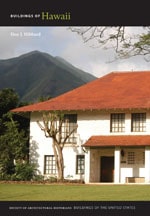
A handsome integration of Japanese forms with plantation construction techniques, intact Buddhist temples such as this have almost disappeared from Oahu. The bold, front-facing irimoya roof and its repetition in the kōhai is a configuration commonly found in Hawaii. Set on a stone foundation, the single-walled building, with three pairs of two-by-two, double-hung sash windows, follows a rectangular floor plan. The nave was expanded by the removal of the front sliding doors and the enclosure of the front lanai with shōji-like panels. The naijin's golden altars were made in Japan, as were the hand-carved ramma. The latter, with their birds amidst the clouds, present images of the heavenly, serene Pure Land. The cusp-arched shōji at the corners of the naijin maintain the Japanese character while recalling the imagery set forth by Bishop Imamura at the Honpa Hongwanji (OA80). The nave's ceiling is made of canec, a fiberboard made from bagasse, which is the stalk that remains after the juice is crushed out of sugar cane. Developed between 1926 and 1930 by the Hawaiian Cellulose Company with the support of the Hawaii Sugar Planters' Association, canec was produced by Hawaii Cane Products in Hilo from 1932 to 1963. Although primarily used for interior walls and ceilings, as here, it was employed as an exterior wall covering in some houses; it is resistant to termites.
This congregation was founded in 1905. The present building replaced the earlier temple which burned in 1936; members of the temple provided the labor.














